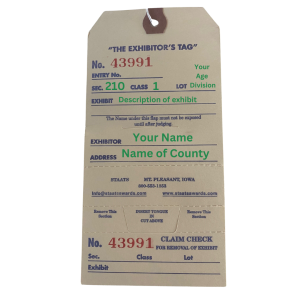
Horticulture Class Display
It’s hard to believe fair season is just around the corner. I remember as a youth the excitement of entering my projects in the county fair. Today I will be sharing tips for preparing your plant project for exhibition at the fair. At the North Florida Fair, youth plant projects are entered in Class 1 of department 210. This includes plants grown in containers or dish gardens, and each youth can enter up to six entries for this class. Youth need to have their plants six weeks prior to the fair; this year that is around September 15. If you are growing your plant from seed or from a cutting, you will want to start much earlier. The exact time will depend on the type of plant you are growing.
You want to select plants that will peak in November or that can be maintained at a good size for exhibit. Here’s a list of plants that have been exhibited in past years, and work well for this time of year in Florida: African Violet, Aloe, Aluminum, Angelonia, Arrowhead Plant, Basil, Begonia, Blue Daze, Cardinal guard/Mexican Firebush, Coleus, Christmas Cactus, Cilantro, Creeping Jenny, Croton, Cuban Oregano, Dianthus, Dieffenbachia, Dracaena, Crossandra, Jade Plant, Ferns, Fittonia, Ghost Plant, Kalanchoe, Lavender, Liriope, Perilla, Euonymus, Marigold, Moss Rose (Portulaca), Impatiens, Marjoram, Mums, Oregano, Oyster Plant, Orchid, Parsley, Pentas, Peace Lily, Ornamental Peppers, Pentas, Peperomia, Persian Shield, Petunia, Philodendron, Pilea, Polka Dot Plant, Portulaca, Pothos, Prayer Plant, Purple Heart, Rosemary, Sage, Salvia, Sedum, Spider Plant, Snake Plant, Stevia, Tarragon, Thyme, Torenia, Vinca, Wax Begonia, Zinnia.
Caring for your Plant
The fantastic thing about exhibiting plants is everyone can grow flowers and vegetables in small spaces using containers. It is also a relatively inexpensive hobby that helps the environment. The main requirement is that you grow plants together with similar light and moisture requirements. Here are a couple of resources to assist you with container gardening from Florida and Iowa.
Plants for exhibition should have good spread, fullness, and height. Branching is often more desirable than extra height. That may mean that the plant needs to be cut back to allow branching and encourage symmetrical growth. A one-sided or unevenly developed plant often indicates that it has not been rotated regularly and has grown toward the sun or source of light.
First decide where your plant will be kept. Is it sunny or shady? Will it get lots of water or a little water? Next select the plants that will meet the location needs. Then find a container to show off your plants for the fair. You want your pot to be in proportion to the plants you planted. You do not want the container to be unstable or overpowering. In our county, we use gallon size black pots for the ease of transport to the fair. However, the fair does not limit or specify the type of container to be used. Talk with your local extension faculty if they are transporting your plants for you since they may have limitations on what they can transport. The biggest thing to remember is the plants are the stars of the show and need to be the eyecatcher, not the container outshining the plants.
 Prepping Your Plant for Exhibition
Prepping Your Plant for Exhibition
After having your plants for six weeks your will need to do a few things to get them ready for exhibit at the fair. Download this checklist to help you prepare!
- You will want to have a saucer to catch water drainage.
- Next clean your pot by removing soil and spray residue from the sides. Remove any excess roots coming out of the bottom of the container. Groom your plant by remove any detritus (dead leaves, sticks etc.) laying on top of the soil. You may need to top dress the container with fresh soil or compost to make it neat in appearance.
- When grooming the plants you want to remove all soil and spray residue from the foliage, stems, and flowers. You can do this by using a damp cloth or soft brush. Be careful not to damage the foliage or petals when doing this step. Next you want to look at the plant for faded blooms, ragged leaves and dead or diseased branches. These should be removed, or trimmed (following the natural shape of the leaf) but stubs or wounds may be noticed by the judge so avoid removing too many leaves and stems.
- If your plant needs to be staked to stand up correctly, stake it but the stake should end below the plant. You want the stake to be as unobtrusive as possible.
- Finally, attach the fair entry tag to your container. Make sure to include the container start date and common plant names to the entry tag or use another label.
Preparing your Entry Form & Exhibitor’s Tag
Entry forms are due to your local 4-H Extension Office by the 1st of October. When you turn in your entry form, your 4-H agent will assign exhibit tags, which you will need to fill out and attach to your plant when it is time to submit for judging. Here is the information you need to correctly complete your entry tag:
- Section – 210
- Class- 1
- Lot- This will be your age division; write “A” for juniors (8-10 years old), “B” for intermediates (11-13 years old), or “C” for seniors (14-18 years old).
- Exhibit- a short description of the item you are entering (example: dwarf coreopsis)
- Exhibitor- Your name
- Address- Name of your county
Scoring
Your plant will be judged the Wednesday before the fair opens. Foliage plants are judged on the quality and appearance of leaves and stems. Colors should be bright, clear, and typical of the plant. Flowering plants are judged for their display of flowers but should not show obvious foliage (leaf) damage. A comparison of the number of open flowers and buds is typically used to evaluate similar entries. You can download the judges’ scoring rubric for more information on how horticulture entries are judged. After judging, a ribbon will be attached to your plant, and the ribbon color will be recorded for the fair office so they can issue you your premium money. 4-H Day at the Fair (November 16) is a great time to check to see what placings your exhibits earned!
Take a little time today to dig in the dirt and create your own container garden(s) for fair exhibits. If you have questions, reach out to your local UF IFAS Extension Office.
Resources:
4-H Youth Development Faculty Bay County Extension

 Prepping Your Plant for Exhibition
Prepping Your Plant for Exhibition

